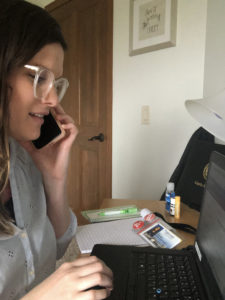Since the beginning of March, Eva Radomski has been calling residents in Dane County who have tested positive for COVID-19.
As part of Public Health Madison & Dane County’s contact tracing team, Radomski, a public health nurse, is part of an effort to connect the dots of how COVID-19 is spreading — hopefully slowing it down along the way.

Public health nurse Eva Radomski working from home as a contact tracer in Dane County. (Courtesy of Eva Radomski)
Radomski said as the state and county move toward reopening, contact tracing will become even more important.
“Contact tracing is a tool that helps slow the spread in a very easy way. It’s a way for us to make a phone call to let [someone] know they’ve been exposed, that they need to isolate, and that stops one more person from spreading the communicable disease, in this case, COVID-19,” Radomski said.
The nuts and bolts of contact tracing is quite simple. Trained tracers — like Radomski — begin by interviewing the person who tested positive for COVID-19 first.
“We start by identifying when their symptoms started … then we go back an additional two days. Then from that date, we ask them who they’ve been around and where they’ve been,” Radomski explains. “They give us, you know, as much information as they can about the people and the contact information to get ahold of them. And then that’s when the contact tracing begins.”
From there, contact tracers reach out to everyone the initial positive case came in contact with.
According to Public Health Madison & Dane County, the number of contacts for each person who has tested positive for COVID-19 has ranged anywhere from 0 to 22, with an average of 2.1 contacts per case.
Radomski said contact tracing gives their 36-person team a chance to best educate those who’ve been exposed to the virus, offering them guidance and recommendations on how to monitor their own health, while also minimizing the likelihood of unknowingly spreading COVID-19 to others.
“A lot of people already know they’ve been exposed,” Radomski said. “However, there are a few people who we do tell them that they’ve been exposed, and they are like any human — frightened or angry, sad, worried — and that’s OK, because then we are the resource for them.”
Once they inform someone they’ve been exposed, contact tracers go over the Centers of Disease Control and Prevention’s (CDC) recommendations for isolation. They also provide information on how best to social distance from household members. Contact tracers finish by providing their contact information, so people can get in touch if they have follow-up questions.
For the most up-to-date information, Radomski encourages people to go to Public Health Madison & Dane County’s website, which is being updated on a regular basis.
For anyone who thinks they’ve been exposed to COVID-19, or are having symptoms of the virus, Radomski is encouraging they go to Dane County’s free community testing site at the Alliant Energy Center. For those not in Dane County, the state Department of Health Services is keeping an updated list and map of community testing sites across Wisconsin.
“Anyone can go get tested, no matter your symptoms,” Radomski said. “There’s drive up, walk up, bike up, any type of transportation available. And if you don’t have transportation, you can reach out to public health and we are more than happy to help arrange transportation for you.”
And while the stress of the moment may make tensions high, Radomski wants people to know contact tracers are there to help clear up some of the uncertainties surrounding COVID-19.
“I think it’s just important to know that when we’re calling you, we’re calling with a helpful heart,” she said. “We are more than willing to take suggestions or willing to dive deep to find extra education or information that you need. So, please reach out to us with any questions or concerns that you might have, because we were more than willing to go that extra mile to make people feel safe at home and in the community.”
==
MUSIC: “#17” by Aphex Twin
“Uncle John’s Band” by Lucius








